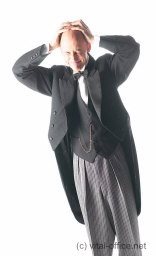Ergonomics and health management:
On following pages we provide a short overview of ergonomics and health management principles:
Ergonomics and health management principles
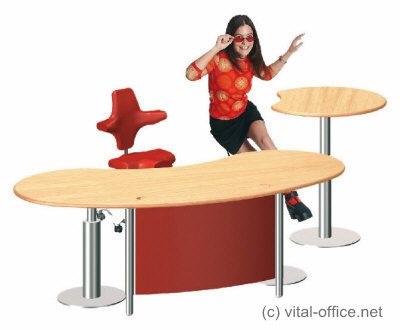
What is ergonomics?
Everyone has heard of ergonomics - after all, the word is widely used in advertising. But to think of ergonomics simply as a way of designing more comfortable goods misses the point - there is much more to ergonomics.
The word ergonomics is perhaps a little intimidating, but behind it lies a very simple idea.
- Ergonomics is about ‘fit’: the fit between people, the things they do, the objects they use and the environments they work in.
- If a good fit is achieved, stress is reduced.
- We are more comfortable and can do things more quickly and easily, and we also make fewer mistakes.
The industrial science, Ergonomics, deals with the stresses and needs of working people. By recognizing and analyzing them the work environment can be better adjusted to the employees.
The main task of ergonomics is avoiding incorrect operations in the security-relevant areas like airplanes, cars and power plants, by adjusting the material for the work and the work environment to the person in an optimal way.
The preserving of the employee’s health is a logical consequence.
Ergonomics is to adapt the workplace to human needs


Stress load model
The individual influences that act upon a person are certain characteristics of different stresses. This means that many small partial stresses caused by office appliances, work processes and the working environment have their effect on the worker. The sum of all these small partial stress loads constitutes the total stress load.
Since the office environment usually does not have a partial stress that immediately causes significant harm to one’s health, it is important to recognize the total stress load and this also over a longer period of time.
Stress load model
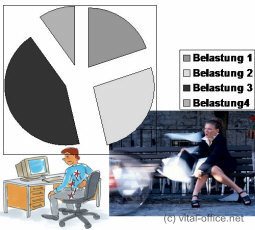
Ergonomic polarity
The human being in the workplace creates a contradiction for himself.
On one hand, humans need social interaction. To be seen and recognized (feedback) is a basic need that is required for healthy personality development. On the other hand, the average office worker wants the greatest amount of privacy possible. He would prefer having an enclosed office for the best possible concentration, and yet at the same time he wants optimum conditions for communicating with coworkers.
It is therefore not wisest to force a 100% solution for one side; rather, it is more effective to strive for a 60/40 solution.
Ergonomic polarity

Branches of Ergonomics:
-
Anthropometrics: to adapt and adjust items to the human body measurements. (form and size of items, adjustability, .. )
-
Physiology: to adapt working conditions to human beings.(lighting, air-conditioning, noise, .. )
-
Psychology: to create a comfortable environment.(colors, arrangements, flowers, .. )
Sociological: covering the needs of group membership -
Informatics: design of Info-devices(see, hear, touch and feel .. )
-
Organization: organization of work-place tasks.
-
Security: prevention of injuries and long term health problems.
Branches of Ergonomics
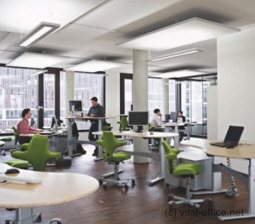
Hygiene, comfort and personal appreciation:
The table-top edge is an important point from an ergonomic viewpoint. It shows us the value of our work quite directly. In accordance with the principle
“The quality of our surrounding work environment determines the quality of our work.”
The table-top conveys to us how attentively and carefully we are required to do our job. For example, you have to be less attentive at a plastic edge than at a solid wood edge.
What is your personal appreciation - Is this equal to the amount your buying department is willing to spend for your desk?
Don’t fool yourself. Exactly this appreciation and this quality is reflected on you every day you spend at your desk.
Since we are constantly in direct contact with the table edge, the shaping of the edge with respect to its hygienic qualities must be assessed. For instance, with traditional chipboard with plastic edge banding, the joint develops very rapidly into unhygienic dirty joint, in particular, because the adhesive used is water-soluble and therefore absorbs the sweat from the surface of the hand.
In practice, unfortunately, not enough attention is given to the shaping of the table top. We are in direct contact with the edge with our underarms all day, the whole week and finally the whole of our working lives.
High-quality table tops manufactured from homogenous material with smoothly profiled edges combine hygiene, comfort and appreciation.
Hygiene, comfort and personal appreciation
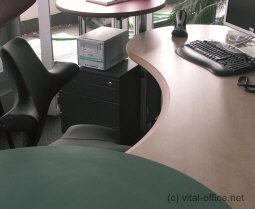
Security and Privacy:
Security and Privacy are preconditions for creativity and true communication and social intelligence. Here we differentiate:
- Security through backing = back coverage
- Security through protection = shield in front
- Security through command = overview of space
- Personal territory = privacy = intimate space
Actually it is quite simple: Above all else, everything you need and everything for which our ancestors fought, is a safe place to live.
Just as our ancestors looked for a place with good protection from behind, you are looking for the same in our modern world. This need is archetypically conditioned. Consequently, a secure workplace with rear protection is the requirement for all further development and exposition of your possible work performance.
We also feel better at the front, if we are not completely exposed. A shield provided the primeval hunter with protection, just like the castle for the knight. The most minimal protection is, for example, a loincloth. It is just the same in the office: In reception, in line with a castle, somewhat more protection is required. Speakers like to have a lectern (shield). In a group office employees are happy with a modesty panel.
Your preference for your own intimate space is somewhat more differentiated. The private sphere is more than the aforementioned security. It also implies a safe space for your individuality. Everyone knows how unpleasant it is if someone else stands too close behind you or next to you.
In practice, we can observe, if you have no security and no defined private sphere in your workplace, (for example, due to unsuitable furniture and a bad room concept), that you then unconsciously. create alternative private areas in your workplace unconsciously.
For example, including by your behavior towards other employees. You behave, for example, more aggressively, more affectedly, more evasively, more threateningly, in a more anti-social way, more defensively, less communicatively, more arrogantly and more reservedly in order to keep the others at a (safe) distance.
Certainly, all forms of behavior which do not conform with your company’s culture and definitely counteract the company’s targets in terms of efficiency and competitiveness. In addition, this kind of negative behavior leads in the long term to personal suffering and health problems.
On the other hand, an ergonomic design in conformity with the premises of security and a privacy sphere promotes friendly, cooperative and constructive communication, social intelligence for new ideas and better competitiveness. At the same time, it facilitates a better quality of life.
On the basis of this security we are unconsciously more friendly and helpful to our colleagues. Our colleagues feel the same. They, likewise, have a safe place and are more friendly, co-operative and helpful.
We are bringing about a change. We are more successful and we enjoy our work. We enjoy working together and appreciate our successes and we will take this energy with us into our private lives
The scenario described above functions in an optimal way if the company culture, company vitalizing processes, employee management and office design are co-ordinated with each other. In our calculation, the unconscious effect of a Vital Office must not be underestimated.
Security and Privacy
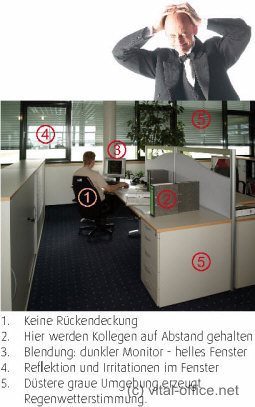
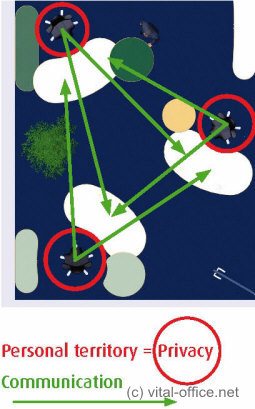
Anthropometrics:
- Adapt table tops to the human body
- Achieve a healthy relaxed forearm support
- Achieve easy access to entire workplace through simple rotation
- Achieve more accessible workspace around you.
Anthropometrics
Be aware of the big difference in needed table heights for small and tall people!
Not using adjustable desks is like driving a car without adjustable seat.
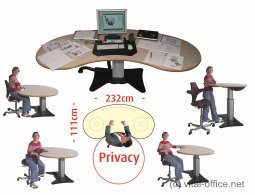
The consistent round Design of the Vital-Office desk tops unleashes new creative spaces and offers optimal ergonomic conditions.
![]()
Ergonomic stress factors:
-
Desk too low or too high
-
Chair without dynamic mechanism
-
Sense of touch: sharp edges
-
fixed positions / no movement
-
Blinding lights (glare)
-
Irritating light reflections
-
”Sleepy” artificial light
-
Exposure (no privacy sphere)
-
Isolation / no team
-
Activity in the back
-
Bad climate
-
Dark or unnatural colors
-
Cold technical environment design
-
Not enough fresh air (oxygen)
-
Stressing Emotions
-
negative noise (anger)
-
Invisible earth vibrations
Ergonomic Vitality factors
-
Soft edges
-
Quality material
-
Adjustable work place items
-
Encourage more dynamics / movement
-
Sun light / full spectrum light
-
Sensitive positioning of workplace
-
View directions towards areas with less difference in luminous density
-
Workplaces with backing
-
Enable view to doors and walking path
-
Let people be part of a group
-
Positive respectful thinking
-
Colors (Black & White are NO colors)
-
Warm design & decorations (plants)
Fresh air (oxygen) -
Joyful atmosphere
-
more laughter and positive team action
-
Live abilities to adapt
Ergonomic stress and vitality factors
